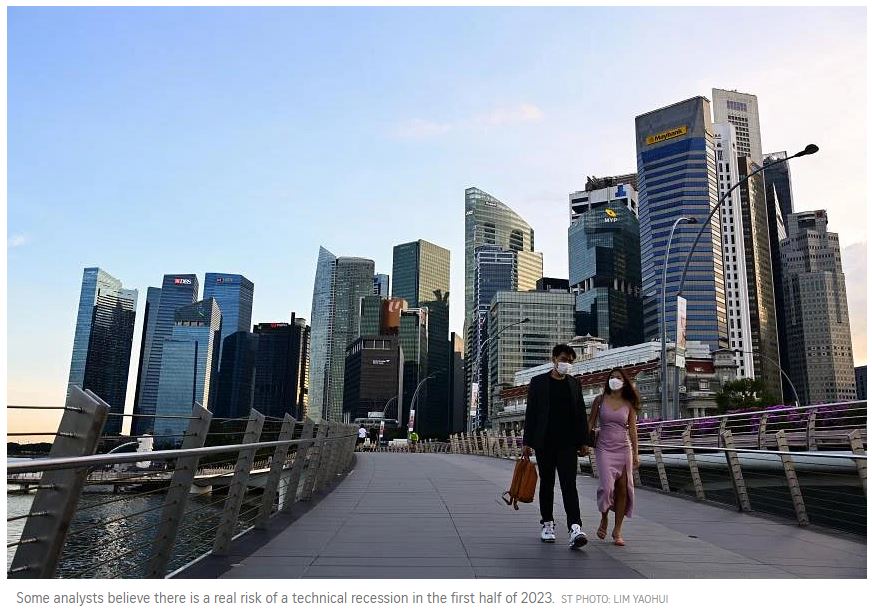Singapore’s slowing growth carries risk of technical recession in 2023: Analysts
SINGAPORE – Singapore may avoid a full-year recession in 2023, but the export-driven economy is set for a bumpy ride, analysts say.
With the economy’s most reliable engine – non-oil domestic exports (NODX) – sputtering to a halt, the domestic services sector fuelled by private consumption is expected to become the main driver of growth.
Still, some analysts believe there is a real risk of a technical recession – two consecutive quarters of negative growth – in the first half of 2023.
Mr Barnabas Gan, senior economist at RHB Singapore, said: “The balance of risks is tilted towards a technical recession in the first half of 2023.”
Dr Chua Hak Bin, regional co-head of macro research at Maybank, said the probability of recession over the next 12 months has risen due to aggressive global monetary tightening and slowing external demand.
Nevertheless, both analysts stressed that any recession will likely be a shallow one due to the tailwinds from the lifting of local mobility and international travel restrictions, which boosts aviation- and tourism-related sectors such as air transport, accommodation, hospitality, food and beverage as well as the arts, entertainment and recreation.
The analysts’ comments followed the maiden forecasts for 2023 by the Ministry of Trade and Industry (MTI) and Enterprise Singapore (EnterpriseSG) – which are nothing short of grim reminders of how global economic conditions have deteriorated this past year.
MTI narrowed its gross domestic product (GDP) growth forecast for 2022 to around 3.5 per cent, from an earlier projection of 3 per cent to 4 per cent. For 2023, it further lowered the bar for GDP growth to between 0.5 per cent and 2.5 per cent.
The forecasts for 2022 and 2023 are far lower than the 7.6 per cent GDP growth achieved in 2021 and show how surging inflation, rising interest rates and supply disruptions from China’s Covid-19 lockdowns and the Russia-Ukraine war have hobbled global demand.
However, Ms Yong Yik Wei, MTI’s chief economist, said that while negative growth in a quarter next year cannot be ruled out, a recession or even a technical recession is not part of the baseline scenario for the ministry.
EnterpriseSG said NODX will shrink by 2 per cent or, at best, see no growth next year. That compares with its forecast of a 6 per cent NODX growth in 2022.
That forecast is based on the expected slide in global demand for semiconductors and oil products, which in turn will depress Singapore’s manufacturing sector’s most active segments of electronics and chemicals.
NODX fell by 5.6 per cent in October, the first decline in 22 months.
While the services sector’s recovery will likely provide a significant offset to weak activity in export-driven manufacturing, how beneficial the tailwinds of reopening will be is a bit hard to predict right now.
For instance, private consumption – a measure of domestic demand – fell by 0.9 per cent in the third quarter of 2022 from the previous three-month period.
The drop came after a 7.1 per cent surge in the second quarter, which most analysts saw as a reflection of pent-up demand as social distancing measures were relaxed.
However, the labour market’s strength is likely to help keep private consumption of domestic services higher.
The third quarter’s unemployment rate of 2 per cent was better than the 2.1 per cent in the second quarter.
The Ministry of Manpower believes unemployment will remain low as there are still a lot of vacancies to be filled, and non-resident employment is still growing.
Non-resident workers, especially those at the higher end of the salary spectrum, will likely add to domestic demand.
Mr Brian Tan, senior regional economist at Barclays Bank in Singapore, said the supply of foreign labour will recover at a more gradual pace despite the pickup in international travel.
Ms Selena Ling, chief economist and head of treasury research and strategy at OCBC Bank, said her forecast for GDP growth of 1 per cent to 3 per cent for 2023 is premised on the assumption that major central banks will pause rate hikes in the first half as inflationary pressures start to ease amid the global slowdown.
Second, China will further relax its zero-Covid-19 policy and shore up its property market through more proactive policy support, which could provide some boost to the regional economies, she added.
“If there is a further escalation of these headwinds, then an outright sequential dip in the quarterly growth momentum cannot be ruled out,” she said.

Source: https://www.straitstimes.com/business/singapore-s-slowing-growth-carries-risk-of-technical-recession-in-2023-analysts


 English
English




